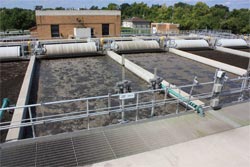Siemens’ retrofit and upgrade technologies and services help wastewater treatment plants meet regulations, while saving energy

The Vertical Loop Reactor system from Siemens can be easily retrofitted into existing space with minimal operator attention. Photo: Siemens AG
Whether treatment facilities need to rehabilitate, retrofit, upgrade or expand existing assets, Siemens offers sustainable solutions that help plants reduce costs, improve operations, comply with new regulations and save energy.
“We are finding that system retrofits are increasingly popular in the face of more stringent effluent discharge regulations and nutrient removal requirements,” said Paul Rice, municipal market manager for Siemens Water Technologies. “Plants can achieve significant operating cost savings by retrofitting their existing infrastructure with newer, energy saving technologies.”
Siemens offers equipment that meets or exceeds discharge regulations in a small footprint that can be easily retrofitted into existing space with minimal operator attention. This includes the VLR vertical loop reactor, Cannibal sludge reduction system, VertiCel aeration system, Orbal oxidation ditch, Trident HS filtration and clarification systems, Forty-X disc filter, Gravisand filtration systems and the Memcor CS submerged ultrafiltration system.
Additionally, Siemens continues to develop innovative new technologies and redesign existing technologies that use less energy and reduce long-term lifecycle costs. For example, by combining the VLR system with the MemPulse membrane bioreactor (MBR), a plant can reduce its overall energy by up to 30%. The Link2Site Flex system is a wireless-to-web remote monitoring and control solution that can be added to equipment or processes to optimize operation through reduced maintenance and service costs.
A city in the Midwest significantly reduced wastewater treatment plant operating costs by upgrading its old conventional plant. The plant abandoned its primary clarifiers, converted its fine-bubble aeration tanks to VLR systems and turned the anaerobic digesters into the Cannibal solids reduction system. They also added two new VLR tanks and three new 80-foot diameter final clarifiers with Tow-Bro clarifier suction removal mechanisms. The upgrade has reduced the plant’s aeration power costs and solids volume, while improving effluent quality.
A sequencing batch reactor (SBR) facility in Pennsylvania needed to improve its total suspended solids removal, as their slow sand filter had ceased to function properly. The solution was a “plug and play” installation consisting of a Forty-X disc filter placed on top of the existing SBR equalization tank. The filter’s small footprint saved the facility additional civil work.
The Sanitary Board of Bluefield, West Virginia experienced filter problems in their wastewater effluent polishing, and decided to upgrade the existing two-pump traveling bridge filters.
They chose to replace all three of their traveling bridge filters with a retrofitted system that incorporated the Gravisand filter system from Siemens. After the installation, the plant’s operators experienced flawless filter performance and desired effluent quality, as well as an easy to operate system with less required maintenance.
Besides providing innovative technologies and equipment, Siemens also offers retrofit and rehabilitation services, which involve conducting a comprehensive review of the client’s water treatment equipment and controls, as well as current operating procedures and data. Siemens then provides a detailed report with recommendations for improving the treatment system.
Further information about solutions for water treatment is available at:
http://www.siemens.com/water
VLR, Cannibal, VertiCel, Orbal, Forty-X, Gravisand, Memcor, Tow-Bro, Link2Site, MemPulse and Trident are trademarks of Siemens Water Technologies, Siemens’ subsidiaries or its affiliates in some countries.
Contact USA:
Karole Colangelo
Corporate Public Relations Manager
Siemens Water Technologies Corp.
847-713-8458 phone
E-mail address karole.colangelo@siemens.com
The Siemens Industry Sector (Erlangen, Germany) is the worldwide leading supplier of environmentally friendly production, transportation, building and lighting technologies. With integrated automation technologies and comprehensive industry-specific solutions, Siemens increases the productivity, efficiency and flexibility of its customers in the fields of industry and infrastructure. The Sector consists of six divisions: Building Technologies, Drive Technologies, Industry Automation, Industry Solutions, Mobility und Osram. With around 207,000 employees worldwide (September 30), Siemens Industry achieved in fiscal year 2009 total sales of approximately €35 billion.
The Siemens Industry Solutions Division (Erlangen, Germany) is one of the world's leading solution and service providers for industrial and infrastructure facilities comprising the business activities of Siemens VAI Metals Technologies, Water Technologies and Industrial Technologies. Activities include engineering and installation, operation and service for the entire life cycle. A wide-ranging portfolio of environmental solutions helps industrial companies to use energy, water and equipment efficiently, reduce emissions and comply with environmental guidelines. With around 31,000 employees worldwide (September 30), Siemens Industry Solutions posted sales of €6.8 billion in fiscal year 2009.
Media Contact
All latest news from the category: Power and Electrical Engineering
This topic covers issues related to energy generation, conversion, transportation and consumption and how the industry is addressing the challenge of energy efficiency in general.
innovations-report provides in-depth and informative reports and articles on subjects ranging from wind energy, fuel cell technology, solar energy, geothermal energy, petroleum, gas, nuclear engineering, alternative energy and energy efficiency to fusion, hydrogen and superconductor technologies.
Newest articles

Superradiant atoms could push the boundaries of how precisely time can be measured
Superradiant atoms can help us measure time more precisely than ever. In a new study, researchers from the University of Copenhagen present a new method for measuring the time interval,…

Ion thermoelectric conversion devices for near room temperature
The electrode sheet of the thermoelectric device consists of ionic hydrogel, which is sandwiched between the electrodes to form, and the Prussian blue on the electrode undergoes a redox reaction…

Zap Energy achieves 37-million-degree temperatures in a compact device
New publication reports record electron temperatures for a small-scale, sheared-flow-stabilized Z-pinch fusion device. In the nine decades since humans first produced fusion reactions, only a few fusion technologies have demonstrated…





















